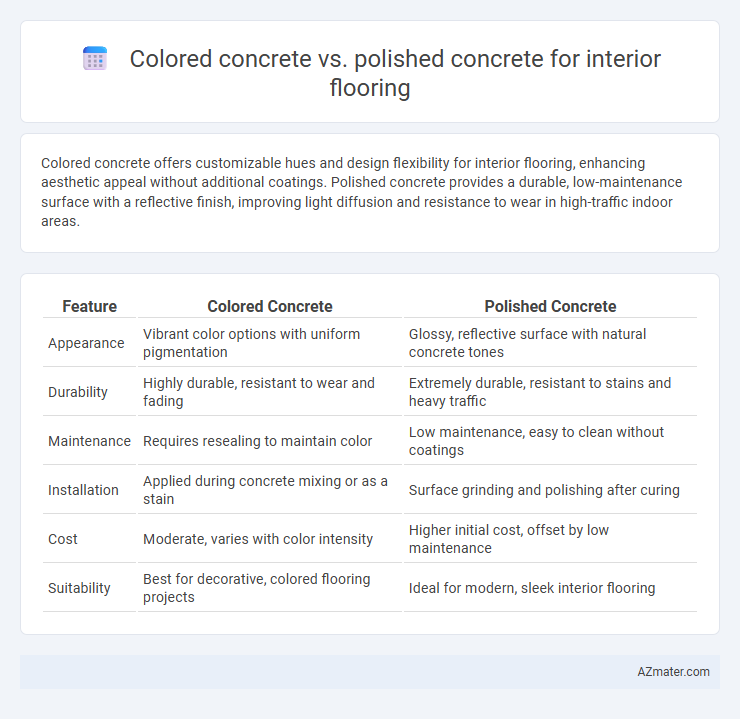Colored concrete offers customizable hues and design flexibility for interior flooring, enhancing aesthetic appeal without additional coatings. Polished concrete provides a durable, low-maintenance surface with a reflective finish, improving light diffusion and resistance to wear in high-traffic indoor areas.
Table of Comparison
| Feature | Colored Concrete | Polished Concrete |
|---|---|---|
| Appearance | Vibrant color options with uniform pigmentation | Glossy, reflective surface with natural concrete tones |
| Durability | Highly durable, resistant to wear and fading | Extremely durable, resistant to stains and heavy traffic |
| Maintenance | Requires resealing to maintain color | Low maintenance, easy to clean without coatings |
| Installation | Applied during concrete mixing or as a stain | Surface grinding and polishing after curing |
| Cost | Moderate, varies with color intensity | Higher initial cost, offset by low maintenance |
| Suitability | Best for decorative, colored flooring projects | Ideal for modern, sleek interior flooring |
Introduction to Interior Concrete Flooring
Interior concrete flooring offers versatile options such as colored concrete and polished concrete, each providing unique aesthetic and functional benefits. Colored concrete integrates pigments into the mix, allowing customized hues that enhance design flexibility and complement various interior styles. Polished concrete features a high-gloss finish achieved through grinding and sealing, offering increased durability, stain resistance, and a sleek modern appearance ideal for high-traffic indoor spaces.
Overview of Colored Concrete
Colored concrete offers a versatile and customizable option for interior flooring by incorporating pigments directly into the concrete mix, resulting in a durable surface available in a wide range of hues and tones. This method provides consistent color throughout the slab, reducing the visibility of wear and damage over time compared to surface-applied stains or dyes. Ideal for both residential and commercial spaces, colored concrete combines aesthetic appeal with long-lasting performance and minimal maintenance requirements.
Overview of Polished Concrete
Polished concrete is a highly durable interior flooring option achieved by mechanically grinding and polishing a concrete surface to a smooth, glossy finish. It enhances the natural look of concrete, offering low maintenance, resistance to stains, and improved reflectivity that brightens interior spaces. Unlike colored concrete, which primarily emphasizes pigmentation, polished concrete focuses on texture and surface treatment to provide a sleek, industrial aesthetic suitable for modern interiors.
Aesthetic Differences: Colored vs Polished Concrete
Colored concrete interior flooring offers vibrant, customizable hues and patterns that enhance the visual appeal and complement various design themes. Polished concrete features a sleek, reflective surface with a natural gray tone, emphasizing texture and sheen for a modern, sophisticated look. While colored concrete provides bold, artistic expression, polished concrete delivers minimalistic elegance with subtle variations in light and shadow.
Durability and Longevity Comparison
Colored concrete offers excellent durability with pigments integrated throughout the matrix, ensuring long-lasting color that withstands wear and fading over time. Polished concrete enhances surface hardness and resistance to abrasion through mechanical grinding and sealing, resulting in a highly durable, low-maintenance finish ideal for high-traffic interiors. Both options provide substantial longevity, but polished concrete typically requires periodic re-polishing to maintain its luster, while colored concrete maintains consistent color and surface integrity with minimal upkeep.
Maintenance Requirements for Both Options
Colored concrete requires regular sealing to prevent stains and maintain vibrancy, with periodic reapplication depending on foot traffic and exposure to moisture. Polished concrete demands less maintenance, as its dense, hardened surface resists stains and wear without the need for sealing, although occasional dust mopping and neutral pH cleaning agents are recommended. Both options benefit from prompt spill cleanup, but polished concrete's durability generally results in lower long-term upkeep costs.
Installation Process: Step-by-Step
Colored concrete installation begins with thorough surface preparation, including cleaning and repairing the slab to ensure proper adhesion of the pigmented mix. Next, colored concrete is poured and evenly spread using screeds and trowels, followed by curing to lock in the color and strength. Polished concrete installation involves grinding the existing concrete surface with progressively finer diamond abrasives, applying densifiers for hardness, and finishing with polishing pads for a smooth, reflective finish.
Cost Analysis: Colored vs Polished Concrete
Colored concrete typically incurs higher upfront costs due to pigments and specialized labor for uniform application, ranging from $8 to $15 per square foot. Polished concrete generally offers a more cost-effective solution, with prices between $3 to $12 per square foot depending on the number of grinding phases and desired finish. Maintenance expenses for colored concrete may be higher over time because of potential staining and sealing needs, whereas polished concrete often requires less frequent upkeep, enhancing its long-term cost-efficiency.
Environmental Impact and Sustainability
Colored concrete flooring uses pigments that can sometimes contain heavy metals, raising concerns about environmental toxicity, whereas polished concrete minimizes chemical use by enhancing the existing slab. Polished concrete significantly reduces the need for additional materials like sealers or coatings, thus lowering the carbon footprint and promoting resource efficiency. Sustainable interior flooring favors polished concrete due to its durability, low maintenance demands, and ability to utilize existing concrete slabs without wasteful replacements.
Choosing the Right Concrete Flooring for Your Space
Colored concrete offers vibrant, customizable hues that enhance interior aesthetics by incorporating pigments directly into the mix, making it ideal for creative, decorative spaces. Polished concrete provides a sleek, glossy finish with high durability and low maintenance, perfect for high-traffic areas requiring a modern, industrial look. Selecting the right concrete flooring depends on factors like design preference, maintenance requirements, and the functional demands of your interior environment.

Infographic: Colored concrete vs Polished concrete for Interior flooring
 azmater.com
azmater.com